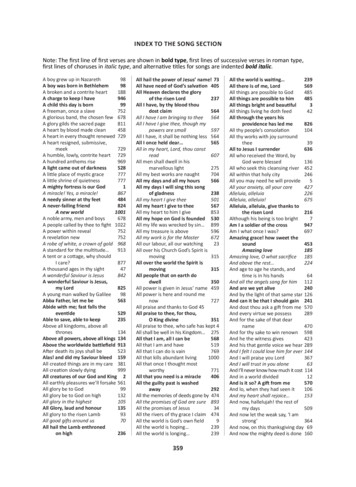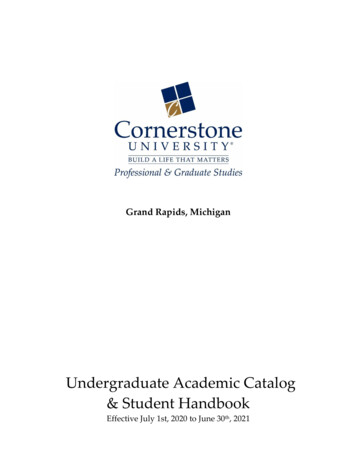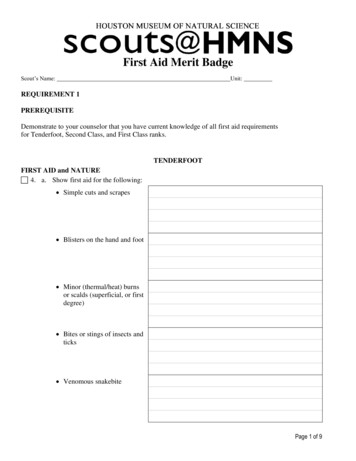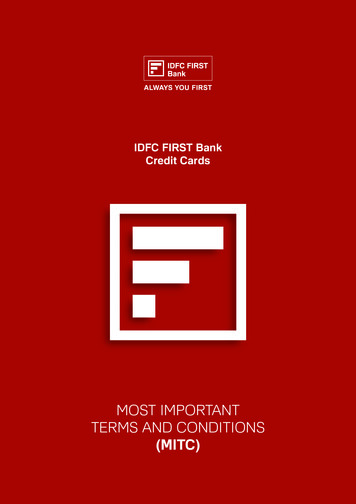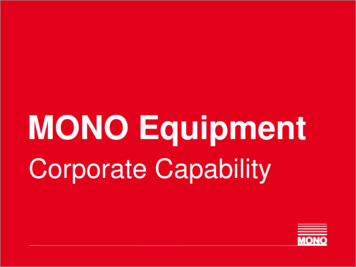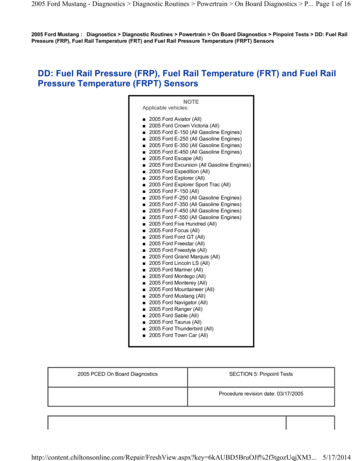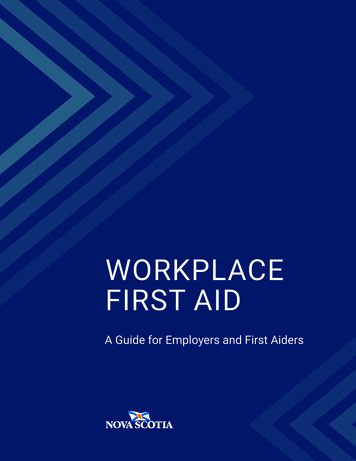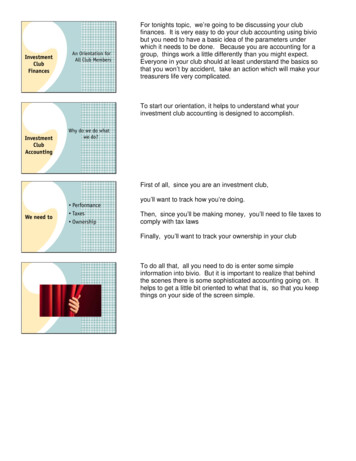
Transcription
InvestmentClubFinancesAn Orientation forAll Club MembersFor tonights topic, we’re going to be discussing your clubfinances. It is very easy to do your club accounting using biviobut you need to have a basic idea of the parameters underwhich it needs to be done. Because you are accounting for agroup, things work a little differently than you might expect.Everyone in your club should at least understand the basics sothat you won’t by accident, take an action which will make yourtreasurers life very complicated.To start our orientation, it helps to understand what yourinvestment club accounting is designed to accomplish.InvestmentClubAccountingWhy do we do whatwe do?First of all, since you are an investment club,We need to Performance Taxes Ownershipyou’ll want to track how you’re doing.Then, since you’ll be making money, you’ll need to file taxes tocomply with tax lawsFinally, you’ll want to track your ownership in your clubTo do all that, all you need to do is enter some simpleinformation into bivio. But it is important to realize that behindthe scenes there is some sophisticated accounting going on. Ithelps to get a little bit oriented to what that is, so that you keepthings on your side of the screen simple.
Pass throughPartnershipInvestment clubs that use bivio are operating as a type ofbusiness entity called a partnership or a type of entity taxed likea partnership called an LLC. There are specific rulespartnerships must follow when it comes to accounting and taxreporting.The partnership business entity is attractive for a variety ofreasons. One of the main ones is that it is a pass through entity.While you do file a partnership tax return, there are no taxespaid directly by your partnership. All the income flows through toyou and you pay the taxes on it on your own personal tax forms.This is in contrast to a corporation where a company pays taxesat a corporate level and then income distributed to owners asdividends is taxed a second time.Prepare TaxesAs a partnership, your club needs to file an informational taxreturn on IRS form 1065. It reports the amount of income yourclub had and the amounts that have been allocated to eachmember to pay taxes on.Part of that return are forms called a K-1’s. One for eachmember. He or she will transfer the information from this form tohis personal tax forms.So what do you need to know about your club accounting as aninvestment club member?ASSETS LIABILITIES OWNERS EQUITYAll accounting is based on a very simple equation. We call thisthe accounting equation. It states that the sum of your assets(what you own), is equal to the sum of your liabilities (what youowe) plus your owners equity. (what you can take away at theend of the day)An investment club is a simple business that does not have anyliabilities.So the accounting equation becomes even simpler. Your clubaccounting tracks what you own,ASSETS OWNERS EQUITYyour assetsAnd what each persons ownership share isYour owners equity
In a club, you’ll have these types of assets.Assets CashStocksStock Mutual fundsStock ETF’sOptions (ActivePartnership)First of all, you’ll probably have some cash. Cash is a clubasset. This includes investments accountants consider“equivalent to cash” such as money market funds.Publicly traded stocksStock mutual fundsStock ETF’sIf you subscribe to our Active Partnership service, you mightalso have bought or sold some options.The choices on this list give you a lot of investments you canchoose from to build a club portfolio.
Assets MLP’sREIT’sCommodity ETF’sFuturesForexReal EstateEtc.It is important to understand that while there are lots of things inthe world you can invest in, you can’t use bivio to account for allof them. You could run a complicated partnership, invest in lotsof different things and pay a CPA thousands of dollars a year toprepare your tax returns. Thanks to the generosity of thepeople who make our tax laws, different types of investmentscan have specialized tax reporting rules you need to complywith. Sometimes clubs inadvertantly get into complicatedinvestments because they are traded in public markets,discussed regularly in investing publications, on TV and on theinternet and you can purchase them from your broker likestocks. However, it is important that you know what you arebuying. For example, we do not provide you with theaccounting or tax reporting you’d need for investments in:Master Limited Partnerships- These are often pipeline andenergy companies. Popular ones are Kinder Morgan, EnbridgeEnergy Partners and Linn Energy.REIT’s-These are real estate investment trusts. A popular onewe often see is Annaly NLYCommodity ETF’s – Just because something is called an ETFdoesn’t meant they it is something we can account for. It willdepend on what type of investment makes up the ETF. Forexample, Commodity ETF’s have become popular recently forpeople who want to own precious metals such as Gold or Silver.These ETF’s actually own the underlying commodity, they donot own stocks. Two popular ones right now are GLD and SLV.The accounting and tax reporting for ownership of preciousmetals is different than that required for ownership of stocks.Bivio does not provide you with the tools you need to account forand report taxes correctly for these investments.We also get asked every now and then if we can account forthings like FuturesForex-Foreign exchange currency tradingReal estate-You can have an investment club that invests in realestate. But you can’t use bivio to do your accounting and taxprep for you.The list could go on and on but I hope you get my point.There are just some investments that you will not be able to ownif you’d like to be able to use bivio to do your club accounting.
There are new types of investments being developed andpromoted every day. We have a page where we list specifictickers for investments we have run into that will cause youproblems. We call this our Before You Invest page. This list isnot comprehensive and we update it as we become aware ofproblems. If you don’t see something on the list and you haveany question about it, please email us at support@bivio.com.We are glad to research an investment for you before youpurchase it and get yourselves into problems.Unfortunately, if you come to us after the fact, things can getpretty complicated. At that point, you may have ended up in asituation where you need to hire a CPA to adjust youraccounting records correctly and prepare the correct tax formsfor your club.AssetsEach evening, after the markets close, the prices on all yourinvestments are updated. The value of all of your investmentsand your cash is added together.This is called your club Valuation or the Net Asset Value (NAV)of your club. You can see it reported on a Valuation report. Itwill change every day because your assets are stocks whoseprice changes daily. Essentially your club is managing a mutualfund.Where Your Club Assets “Live”Your club assets may “live” in several different places. You willsee any accounts you have listed on the Accounts page. Inorder to be able to reconcile your accounts each month,transactions are tracked in bivio in an account representing theaccount they actually occur in.But it is important to understand that for the purposes of youraccounting, all your assets are part of one pool of assets. Nomatter what account they “live” in, they are available forinvesting or paying club expenses.At bivio, we like to encourage you to keep your club financialoperations as simple as possible so nobody has to be anaccountant and everyone can focus on the fun part of being in aclub which is picking stocks. For simplicity in keeping your clubrecords, we highly recommend that you try and operate withonly one account. Each account that you have needs to bereconciled each month. The less accounts you have, the lesswork for your treasurer. Many brokers now offer checking andeven if they don’t you should actually have minimal reasons toneed checks for anything. There are other options you canuse to pay the infrequent expenses an investment club shouldhave.
We have made it very simple for your club treasurer to keep yourrecords. All they need to do is make sure that all thetransactions from your brokerage are entered in bivio. If you useAccountSync, this will happen automatically.Treasurers Job GE DividendsInterestSYK QSIICTSHFORR BOAMemberPaymentsClub ExpensesDeductibleNon DeductibleMemberWithdrawalsThese transactions will include income such asdividends andinterest coming into your club from your investments.Cash will also come in as you make your regular contributions.As part of your investing activities, cash will be used to buystock. Cash will be received from selling stock.Every so often, you will pay for an expense related to havingyour club and managing your portfolio or a member will want towithdraw some of his assets.ASSETS OWNERS EQUITYThere is no distinction between money your members contributefor investing and money contributed for expenses. Deductibleand Non Deductible expenses are paid out of your club assetsas are member withdrawals.All changes in clubs assets determine your club investmentreturn.
Fees Versus PaymentsFeeExpenseSYKQSIIGEPETS CTSHExpenseSometimes clubs want to keep expense money “Separate” frominvesting money. It is fine to keep some of your cash uninvestedif you know you have an expense coming up that you want touse it to pay. Any cash you have available can be used foreither investing or paying expenses. You do not record membercontributions differently if they will be used to pay club expensesrather than invest. There used to be a method in clubaccounting where member deposits could be recorded assomething called “Fees” Fees were contributions by membersthat did not purchase units. This has been restricted to beingused only when a penalty against a member is being assessed.There are two reasons for this.First, there was a common misunderstanding that “fees” andwhatever expenses they were used to pay were somehow keptseparate from the investing pool.This is not the case. Any deposits recorded in your clubaccounting become part of your club assets.Any expenses recorded affect your portfolio return.
Asking them to record member payments differently if they willbe budgeted to use for expenses‐cont.Deposit5 MemberFees@ 40 200TaxAllocationDeductibleClub Expense 20025%20%25%20%10%50405040205040504020The second problem with Fees is that they affect memberownership differently than people think. A member depositrecorded as a “Fee” goes into the general club assets andincreases the value of each members share of the club based ontheir ownership percentage.Suppose you have 5 members in your club with these ownershippercentagesand you have an upcoming expense for 200. You ask eachperson to contribute 40 toward that expense and you record itas a fee.This is actually the way the money will be divided up betweenthe members.While each person has contributed the same “Fee”, they do notexperience the same change in value of their share of the club.Nor are they are they allocated the same amount of thededuction for the Expense. Santa has contributed 40 but willbe able to take a 50 deduction for the expense. Queen hasalso contributed 40 but she will only be able to take a 20deduction for the expense.If you had recorded these contributions as payments, thisproblem would not exist. Each person would receive the fullcredit for the amount they’d contributed to their account. Thereis no reason to deposit money differently just because it is beingused to pay expenses. Record all member contributions aspayments so that each member’s club ownership is correctlyadjusted.TransactionsAll your club’s transactions pertaining to your club assets needto be recorded in the account they occur in either automaticallyby AccountSync or manually by your treasurer. It is veryimportant that they be recorded on the correct dates and thatyour records be kept up to date. It is also important that youtrack all of your club’s financial accounts in bivio and that yourecord all of the transactions that happen in those accounts.So that’s what’s important to know in terms of the Assets side ofyour record keeping.ASSETS OWNERS EQUITYThere are also important things to understand about how yourclub ownership is tracked.
As a member of a partnership,Partnership Capital interest Tax basis Capitalgains/lossesyou have a capital interest in a business. There are similaritiesbetween this and the ownership interest you have in acorporation when you own stock. There are special tax rulesthat apply when funds are put into your club and when funds aretaken out.Just like when you own stock, you have a basis in yourinvestment in your cluband you might have capital gains or losses when you withdrawfunds from your club.One thing club members often don’t know is that the capitalgains tax on withdrawals from your club is in addition to thetaxes you will pay each year when you are given your K-1’s. Butdon’t worry, you won’t get taxed twice. One of the things biviodoes for you is to track all the information about your financialhistory with the club so that when you eventually withdrawmoney, you will have the information you need to pay theappropriate taxes.There are actually some nice tax rules relating to withdrawalstaken from partnerships that you can use to your benefit to helpyou manage your taxes. We’ll discuss those later.Your tax basis is determined byTax BasisMember contributions /- Income or losses Dividends/interest- Expenses- Withdrawalsthe amount you’ve contributed over the years,plus or minus your share of any income or losses your club hasrecognized by selling investments,plus your share of any dividends and interest you’ve received,Minus your share of any expenses andminus any money you’ve withdrawn from the club.These are the things that have been reported to you each yearon a K-1 and you’ve been taxed on your personal taxes.
You can find out what yourtax basis is at any time, on the member status report. If youwithdrew all your money from the club on the date of the reportyou would have a capital gain or loss equal to the differencebetween this column and theCurrent market value of your share of the club shown in thiscolumn.OwnershipQSIISYK GE PETS FORRClub OwnershipSYKQSIIGEPETS CTSHClub Assets CTSH To determine how to report your share of taxes and keep yourtax basis accurate, we need to allocate income and expenses toeach member. To do this, we need to keep track of yourownership percentage. Club members do not own a specificpercentage of each of the individual assets of the club, they owna percentage of the total assets. BOAWe account for your ownership using shares or units. Owningunits is just like owning shares in a mutual fund. Each time youcontribute money to your club you purchase units,if you’d like to take some money out, you redeem units. Eachday, the value of a unit is determined by dividing the total assetvalue of your club by the number of units outstanding. You canfind the daily value of a unit on the valuation report I showed youearlier.The reason we track ownership using units is that bivio isdesigned to track unequal ownership. This gives you thegreatest flexibility to have an investment club even if everyonehas not or cannot contribute the same amount at the same time.Each members percent of ownership is based on the number ofunits they own. The total value of their share on any day can bedetermined by multiplying the number of units they own by thatdays unit value.
To properly account for this, member contributions andwithdrawals are recorded a little differently than any other type ofdeposit or expense.They are recorded asAccounting MembersPayments andWithdrawals using forms you can access from the membersscreen. After you fill them in, we do the accounting to add orsubtract the appropriate number of units to your account and toadjust your tax basis correctly.One of the pieces of information you will provide on both themember payment and withdrawal form is a“valuation date”. The value of a unit on that date will determinehow many units a member receives or redeems.To keep your record keeping the simplest, we recommend thatyou use the date of the deposit as the valuation date. That way,things work just like they would in a mutual fund. Members buyclub shares at their value on the date of their contribution.Allocating Income and Expenses5/125%5/15DividendReceived- 1005/18DeductibleClub Expense dendReceived- 1003020%20%15%15%20201515When your investments earn income it is divided up by thenumber of units and you are allocated your portion based on thenumber of units you own on the date the income is received.Ownership percentages may change every time a membercontribution is recorded. This makes the dates of entries in yourclub accounting more important then dates in the record keepingfor other organizations that you may have done. We call thistime based allocation.Here’s an example of how income and expenses might beallocated to members over the course of a month.
IndividualExpenses Subscriptions Stock Analysis Tools Educationalmaterials forpersonal library Shrimp cocktailsand martinisInvestment club accounting is designed to account for expensesthat apply to all the members of the club and that can be sharedeither in proportion to each members ownership percentage or inan equal dollar amount by each member.It is not designed to account for expenses that do not apply tothe entire club. We call these Individual expenses. Here aresome examples of them:Subscriptions-If everyone doesn’t participate in the subscriptionthe same way. A common example of this is the personalportion of a Better Investing membership or an individualManifest Investing membership where some club members wantit and others don’tStock Analysis Software tools-Again, unless your club feels thisis a club expense that your club should use club funds topurchase for each member, this is an individual expense. Ifindividuals want individual copies, they should purchase it forthemselves directly. You should not purchase it from clubaccounts.Educational Materials for One members personal libraryIndividual share of club dinner-unless you are dividing up adinner tab based on member percentage ownership or equallybetween everyone, don’t pay it with a club check or from a clubaccount. There is no easy way to try and allocate the costs inany other way to individual members.Don’t worry, there isNOBENEFITIndividualExpensesAllocating Income and Expensesno benefit to paying these types of expenses from your clubaccounts. If you do so, you will only make your treasurers jobharder for no reason. To keep things simple, have individualspay expenses directly that only apply to them.At the end of the year, each members income and expenseallocations are tallied up and used to prepare the K-1 tax formsthey will receive. As described earlier, K-1’s tell you the taxableamounts you need to report and pay taxes on on your personaltaxes. Your tax basis in the club is also adjusted by theseamounts.The amount each member is allocated is shown on the MemberTax allocations report
Month after Month Month“Equality” Year after Year YearIn a club, everyone is equal in the sense that income andexpenses are allocated to you based on the number of sharesyou own. Just as with a mutual fund, the number of shares youown will depend on the amount of money you contribute and theprice of a share on the date you make your contribution.If I own more shares than you do, I will receive a greater totalamount of income. This makes sense. It is inevitable thatdifferent club members will own different numbers of units. Aninvestment partnership is a long term undertaking. The only wayeveryone would own exactly the same number of shares is ifeveryones contributions were recorded for exactly the sameamounts on exactly the same days,Month, after month, after month (click, click, click)Year after year after year (click, click, click) Life happens“Equality”But, LegitimateLife Happens Personal issuesPeople miss payments for legitimate reasons WithdrawalsPeople will have times where they can’t contribute asmuch as they used to New MembersPeople might need some of the money they have investedin your clubPeople may want to join your clubIt doesn’t make sense to make members leave your club ornot allow new members to join if they will activelyparticipate but are unable to have quite the samemonetary stake as other members.
It’s not going tohappen“Equality”It doesn’t matterWe can tell you after years of participating in and working withinvestment clubs,That equal ownership is just not going to happen.But the good news is that it doesn’t matter. Your clubaccounting is designed to account for everyonespercentage of ownership accurately. If your treasurer isreconciling the books correctly each month, you can besure your ownership is being tracked properly and you arebeing allocated the same amount of income and expensesin proportion to your ownership share as everyone else.Focus on learning and working together to optimize yourportfolio performance.If your portfolio grows well, all members will benefit, even if theydon’t benefit by exactly the same total amounts. You will benefitequally based on the number of units you own and the dates thatyou made contributions to the club. You are a group workingtogether to learn to manage a mutual fund. The fund doesn’tcare who owns what.What matters is that each member is committed to participatingin the group both monetarily and by providing research andeducation, not that each person owns exactly the same share ofthe club.WithdrawalsSpecial TaxConsiderationsThere are some interesting tax benefits to being a member of apartnership. They relate to taking money out of your club. Ofcourse, withdrawals that are made too often make it difficult tomanage an investment portfolio. Ask any fund manager whosemutual fund suddenly goes out of favor.But, there are cases where you or another club member mightneed to make a withdrawal so it is interesting to understand howthey work.
First, you need to understand that there is more you need to dowhen someone withdraws than just look at what their account isworth and write them a check. This is a business you arewithdrawing money from and there is a lot of accounting weneed to do to update your records correctly and prepare yourtaxes correctly. You don’t have to do the accounting yourself butyou do have to know you need to determine the withdrawalamount and enter the withdrawal entry using a specialwithdrawal form.WithdrawalsYou’ll find it by selecting the withdraw button on theAccounting Members page. We’ll take the information you enterand adjust your club records correctly. We’ll be discussingentering withdrawals in more depth in our treasurers trainingsession later this month. Make sure you don’t give a clubmember a check or tell a club member what they will receivewithout an understanding of how to fill in this form.If you need to withdraw some, but not all of your funds from yourclub, you can do so with no tax consequences as long as youtake cashPartialWithdrawals Cash No current taxes dueif amount withdrawnis less than your taxbasisand withdraw less than your tax basis. We call this a partialwithdrawal.If you are paid for a complete withdrawal using cash plusappreciated stock,FullWithdrawals Cash plus appreciatedstock Gain deferred tillstock is soldany gain you might need to report on the amount you receive willbe deferred until you sell the stock. The basis in the stock youreceive will be your tax basis in the club minus the amount ofany cash you receive with the stock.A gain that is taxed in the future is usually better than a gain thatis taxed today so this presents some interesting opportunities foryou to defer gains on your investments, perhaps to a point intime when you have some capital losses to use to offset them.If you never sold the stock, and it continued to show a gain whenyou died, your gain would never be taxed. The basis wouldstep up to fair market value for the people that inherited it.
So those are some basics all the members of your club shouldunderstand about your club accounting. There are just a coupleof other things to know about your finances.ASSETS OWNERS EQUITYWhen You’llReceive YourK-1’sMarch 1Don’t expect to file your personal income taxes as early as youmight have before you were in an investment club. You willneed the income and expenses from your club K-1’s to report onyour personal taxes.But, before your treasurer can prepare them, they will have toverify your club records against the 1099 forms from yourfinancial institutions.Financial institutions have until February 15 to send them to yourtreasurer. You’ll probably find that a reasonable date to expectthe filled in forms from your treasurer is March 1.ReconciliationMonthlyMatch brokerageConfirmContributionsYearlyAuditAs we’ve discussed, dates of your transactions are veryimportant in your club accounts. It is important that you knowthat your club records are being kept accurately.As part of your monthly treasurers report, your treasurer shouldverify (and be able to demonstrate)that your club records match the records from your brokerage.They should also provide you with a report you can use toconfirm your member contributions have been recordedaccurately.In addition, you should plan to do a yearlyclub audit where members other than the treasurer confirm yourrecords.Mistakes that affect taxes are usually easy to fix before taxes arefiled. But things can become very difficult after that. It is ineveryones best interest that members other than the treasurerare keeping an eye on the accuracy of your club records.
Your club treasurer does not haveto be an accountant!In summary, if all the members of your club have a basicunderstanding of your club finances your club treasurer does nothave to be an accountant. In fact, your club accounting shouldbe very simple and anyone should be able to do it. As we’vebeen discussing, it is a little different than what people mayexpect or be used to. The only time it becomes difficult is whenclub members who don’t have a basic understanding of thingstry and get their treasurers to do things that create problems.If you don’t understand something your treasurer is doing or tellsyou they can’t do, don’t put your treasurer on the spot to be ableto explain all the reasoning behind it. Any club member shouldfeel free to email us at support@bivio.com with any questions.We’re glad to help clarify things for not only your treasurer butfor any other member of your club.Just to summarize the basicsBasics Correct records No individual expenses Payments andwithdrawals Type of investment Definition of equality Ask questionsVerify your records- this can’t be stressed enough. Askquestions if you see something like a negative balance ona bank account. The current state of your finances isdependent on the dates of all the historical transactions.Make sure your records mirror what is happening in yourfinancial accounts.Only use your club financial accounts for investmentrelated transactions that apply to all club membersRecord all member Contributions as payments andpayouts as Withdrawals using the correct formsIf you are unsure whether an investment is somethingthat can be accounted for by bivio, ask us about it beforeyou purchase it.Define equality as meaning that everyone is allocated thesame amount of income and expense per unit of the clubthat they own. But let go of the need for everyone to ownthe same percentage of the club.Ask us at support@bivio.com if you have questions. We’reglad to explain things to any member of a club. Expectyour treasurer to know how to use the program but don’texpect them to know all the underlying accounting.
investment club accounting is designed to accomplish. We need to Performance Taxes Ownership First of all, since you are an investment club, you'll want to track how you're doing. Then, since you'll be making money, you'll need to file taxes to comply with tax laws Finally, you'll want to track your ownership in your club


